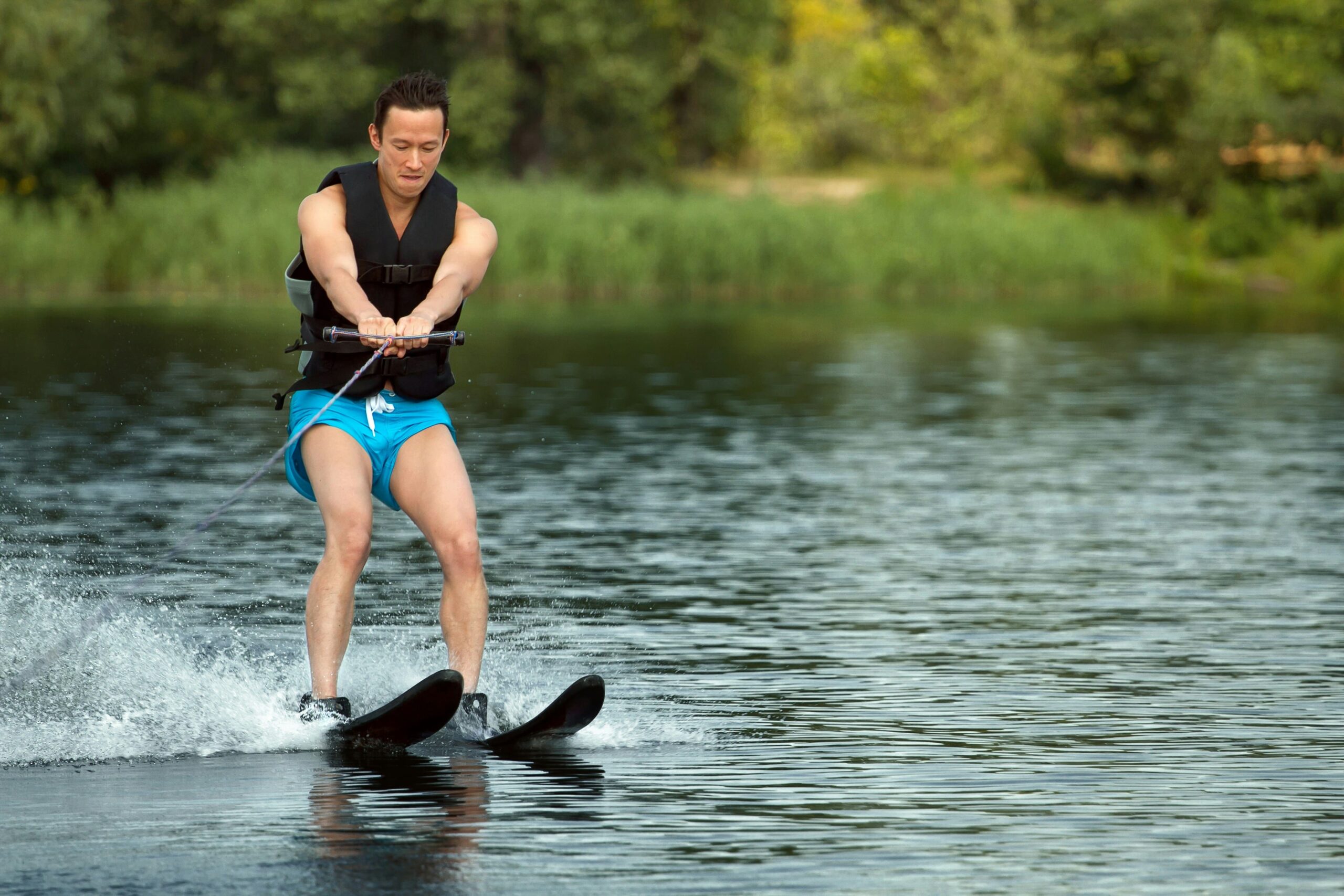Introduction:-Waterskiing is an exhilarating water sport that combines elements of skiing and surfing to create a unique and adrenaline-pumping experience. Born out of the desire to harness the power of the waves, waterskiing has evolved into a popular recreational and competitive activity enjoyed by enthusiasts around the globe. In this deep dive into the world of waterskiing, we’ll explore its history, the equipment involved, techniques, and the thrill of gliding across the water at high speeds.
The Birth of Waterskiing:
Waterskiing’s roots can be traced back to the early 20th century when individuals sought new ways to explore the water. In 1922, Ralph Samuelson, a native of Minnesota, is credited with being the first person to waterski. Samuelson experimented with different materials and techniques until he successfully maneuvered the waters on a pair of homemade skis. Since then, waterskiing has evolved significantly, incorporating innovations in equipment and techniques that have propelled it into the mainstream.
Equipment:
Waterskiing requires specific equipment designed to handle the unique challenges posed by gliding on water. The key components include:
-
Skis: The foundation of waterskiing lies in the skis. Typically made of wood, fiberglass, or a combination of materials, waterski designs have evolved to provide stability, buoyancy, and control. Modern skis come in various shapes and sizes to accommodate different skill levels and styles.
-
Bindings: Bindings secure the skier’s feet to the skis, providing stability and control. Advanced bindings offer adjustable features to customize the fit according to the skier’s preferences.
-
Rope and Handle: The towrope is an essential element, connecting the boat to the skier. Waterski ropes are designed to reduce drag and provide a consistent pull. The handle, typically made of rubber or foam for grip, allows skiers to maintain control and execute maneuvers.
-
Boat: A powerful boat is essential for waterskiing. Boats designed for this purpose are often equipped with specialized features, such as a ski pylon or tow eye, which ensures an optimal towing angle for the skier.
Techniques:
Mastering the art of waterskiing involves a combination of balance, coordination, and technique. Here are the fundamental techniques that every aspiring waterskier should be familiar with:
-
Deep Water Start: The deep water start is the initial phase where the skier begins in the water, holding onto the towrope with the skis parallel. As the boat accelerates, the skier gradually rises to the surface, maintaining balance to prevent tipping.
-
Body Position: Achieving the right body position is crucial for stability and control. Skiers should keep their knees slightly bent, weight forward, and arms straight to maintain balance and absorb the impact of the waves.
-
Turning: Waterskiing involves navigating turns, and mastering the technique is essential for an enjoyable experience. The skier shifts their weight and leans in the desired direction while keeping a firm grip on the handle, guiding the skis through the turn.
-
Jumping and Tricks: Advanced waterskiers often incorporate jumps and tricks into their routine. These maneuvers require a combination of skill, strength, and timing. Jumping off the wake created by the boat or executing spins adds an extra layer of excitement to the sport.
Competitive Waterskiing:
Waterskiing has evolved beyond a recreational activity into a competitive sport with a dedicated following. Competitive waterskiing includes various disciplines, each showcasing the skills and agility of the athletes:
-
Slalom: In slalom skiing, the skier navigates a course marked by a series of buoys. The challenge lies in weaving through the buoys at high speeds, with the towrope attached to one ski.
-
Trick Skiing: Trick skiing involves executing a series of predetermined maneuvers, spins, and flips within a set time. Judges evaluate the skier’s performance based on the difficulty and precision of the tricks.
-
Jump: The jump event is a test of distance as skiers use a ramp to launch themselves into the air. The objective is to cover the maximum distance before landing in the water.
The Thrill of the Waves:
Waterskiing offers a unique blend of excitement, skill, and connection with the water. The sensation of gliding effortlessly over the surface, propelled by the boat’s power, is unmatched. The adrenaline rush and the wind in your face create an unforgettable experience that keeps enthusiasts coming back for more.
The connection between the skier, the boat, and the water is a harmonious dance, where every move and shift in weight are translated into a graceful glide or an exhilarating jump. The sound of the water splashing against the skis and the boat’s engine humming in the background create a symphony of excitement that is the hallmark of waterskiing.
Discover the art of windsurfing with our exhilarating sports packages Bodybuilding and Bog snorkelling. Ride the wind, master the waves, and create memories that last a lifetime.
Waterskiing is not just a physical activity; it’s a mental challenge that requires focus, concentration, and quick reflexes. As the boat accelerates, the skier must adapt to the changing conditions, adjusting their body position and responding to the boat’s movements to maintain balance and control.
Beyond the physical and mental aspects, waterskiing also fosters a sense of community among enthusiasts. Whether it’s a leisurely weekend outing with friends or a competitive event with fellow skiers, the shared passion for the sport creates bonds and memories that last a lifetime.
Safety Considerations:
While waterskiing is undeniably thrilling, safety should always be a top priority. Here are some essential safety considerations for waterskiing enthusiasts:
-
Life Jackets: Wearing a properly fitted and Coast Guard-approved life jacket is non-negotiable. It provides buoyancy and ensures the skier stays afloat in case of a fall.
-
Communication: Clear communication between the skier and the boat driver is crucial. Establishing hand signals and a pre-determined communication system ensures a smooth and safe experience.
-
Boat Maintenance: Regular maintenance of the towing boat is essential. Check the condition of the towrope, handle, and boat systems to prevent accidents caused by equipment failure.
-
Weather Conditions: Pay attention to weather conditions before heading out. Strong winds, rough waters, or storms can create hazardous conditions, making it unsafe for waterskiing.
Conclusion:
Waterskiing is more than just a water sport; it’s a dynamic and thrilling experience that brings together nature, skill, and community. From its humble beginnings in the early 20th century to its current status as a competitive sport, waterskiing has captured the hearts of adventure seekers worldwide.
Whether you’re a beginner learning the basics or an advanced skier pushing the limits with tricks and jumps, the joy of waterskiing lies in the sense of freedom and connection with the water. As the boat pulls you across the waves, and the wind rushes past, the world fades away, leaving only the thrill of the ride.
So, whether you’re seeking an adrenaline rush or a leisurely day on the water with friends, waterskiing offers a unique and unforgettable experience that continues to make waves in the world of water sports. Strap on your skis, feel the pull of the towrope, and let the adventure begin.














